NCERT Solutions for Class 6 Maths Chapter 11 Algebra
NCERT Solutions for Class 6 Maths Chapter 11 Algebra are discussed in this article. These NCERT solutions are created by expert team at careers360 considering the latest CBSE syllabus 2023. This is a very important branch of mathematics comprising 5 exercises and 27 questions. You will get NCERT Class 6 Maths solutions of chapter 11 for these all questions. In this NCERT solutions for Algebra class 6 Maths chapter 11, you will study algebraic expressions. This chapter of NCERT will give you some basics of algebra. These CBSE NCERT solutions for Class 6 Maths chapter 11 algebra are very useful in solving many real-life problems using variables.
This Story also Contains
- NCERT Solutions for Class 6 Maths Chapter 11 Algebra - Important Formulae
- NCERT Solutions for Class 6 Maths Chapter 11 Algebra - Important Points
- NCERT Solutions for Class 6 Maths Chapter 11 Algebra
- NCERT Solutions for Class 6 Maths Chapter 11 Algebra (Intext Questions and Exercise)
- NCERT Solutions for Class 6 Maths Chapter 11 Exercise 11.1
- NCERT Solutions for Class 6 Maths Chapter 11 E xercise 11.2
- NCERT Solutions for Class 6 Maths Chapter 11 E xercise 11.3
- NCERT Solutions for Class 6 Maths Chapter 11 Exercise 11.4
- NCERT Solutions for Class 6 Maths Chapter 11 Exercise 11.5
- Key Features of NCERT Solutions for Class 6 Maths Chapter 11 Algebra
- NCERT Solutions for Class 6 Mathematics Chapter Wise
- NCERT Solutions for Class 6 - Subject Wise
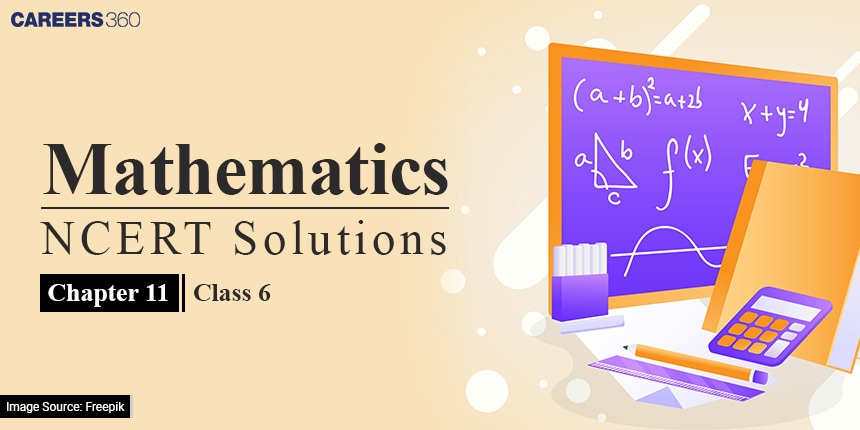
There are many questions in solutions of NCERT for Class 6 Maths chapter 11 algebra where you will learn to form an equation and solve them. Apart from that, there are some practice questions given at the end of every topic for conceptual clarity. NCERT Solutions for Class 6 are prepared by expert faculty to clear doubts which will aid you to understand the concepts given in NCERT 6 Class Maths Syllabus. Scroll down to access NCERT solutions for Class 6 Maths chapter 11. Also, Check NCERT Solutions to get class 6 to 12 solutions for Science and Maths. Understanding the concept of variables and equations are mandatory for our higher studies. So solving all the NCERT questions are mandatory. Solve as many questions as possible from this chapter.
NCERT Solutions for Class 6 Maths Chapter 11 Algebra - Important Formulae
literal numbers or literals = Letters to represent numbers
Commutative property of addition, a + b = b + a, where variables a and b can represent any number.
Consider two literal numbers x and y
x∗y = xy
5∗x = 5x
x∗3 = 3x
a∗a∗.............∗a (12 times ) = a12
In expressions like this x9, the number 9 is called the index or exponent, and the letter x is called the base.
Constant = Same numerical value
NCERT Solutions for Class 6 Maths Chapter 11 Algebra - Important Points
Patterns using matchsticks: Exploring the arrangement of matchsticks to create letters and shapes, identifying the number of matchsticks required for repeating a given shape.
Variable: A symbol or letter (e.g., n) that represents a quantity or value that can vary or change. The value of a variable is not fixed and can take on different values.
Fixed value: Some quantities, like the number of angles in a triangle, have a specific and unchanging value. They are not variables.
Expressing relations: Variables allow us to express relationships and connections between quantities in various practical situations.
Operations on variables: Variables can be manipulated using operations such as addition, subtraction, multiplication, and division, similar to fixed numbers. Expressions involving variables can be formed, such as x - 3, x + 3, 2n, 5m, 3p, 2y + 3, 3l - 5, etc.
General rules: Variables enable us to express general rules and principles in both geometry and arithmetic. For example, the
Equation: A mathematical statement that equates two expressions or quantities. It states that the expression on the left-hand side (LHS) is equal to the expression on the right-hand side (RHS), using the equal (=) sign. For example, x - 3 = 10 is an equation.
LHS and RHS: An equation has two sides, the left-hand side (LHS) and the right-hand side (RHS), with the equal (=) sign in between.
Solution of an equation: The specific value(s) of the variable that satisfy the equation, making both the LHS and RHS of the equation equal. These values are called the solutions of the equation.
Trial and error method: A method for finding the solution(s) of an equation by systematically trying different values for the variable and checking if they satisfy the equation. Different values are tested until the correct value that satisfies the equation is found.
Free Download NCERT Solutions for Class 6 Maths Chapter 11 Algebra For CBSE Exam
NCERT Solutions for Class 6 Maths Chapter 11 Algebra
NCERT Solutions for Class 6 Maths Chapter 11 Algebra (Intext Questions and Exercise)
NCERT Solutions for Class 6 Maths Chapter 11 Exercise 11.1
(a) A pattern of letter T as ![]() .
.
(b) A pattern of letter Z as ![]() .
.
(c) A pattern of letter U as ![]() .
.
(d) A pattern of letter V as ![]() .
.
(e) A pattern of letter E as ![]() .
.
(f) A pattern of letter S as ![]() .
.
(g) A pattern of letter A as ![]() .
.
Answer:
(a) A pattern of letter T as ![]() $=2n$ ( because 2 matchsticks are used )
$=2n$ ( because 2 matchsticks are used )
(b) A pattern of letter Z as ![]() $=3n$ ( because 3 matchsticks are used )
$=3n$ ( because 3 matchsticks are used )
(c) A pattern of letter U as ![]() $=3n$ ( because 3 matchsticks are used )
$=3n$ ( because 3 matchsticks are used )
(d) A pattern of letter V as ![]() $=2n$ ( because 2 matchsticks are used )
$=2n$ ( because 2 matchsticks are used )
(e) A pattern of letter E as ![]() $=5n$ ( because 5 matchsticks are used )
$=5n$ ( because 5 matchsticks are used )
(f) A pattern of letter S as ![]() $=5n$ ( because 5 matchsticks are used )
$=5n$ ( because 5 matchsticks are used )
(g) A pattern of letter A as ![]() $=6n$ ( because 6 matchsticks are used )
$=6n$ ( because 6 matchsticks are used )
Answer: Letter "T" and "v" has pattern 2n because 2 matchsticks are used in these two letters.
Answer: Cadets in a row = 5
number of rows = n
Thus, the total number of cadets = 5n
Answer: Mangoes in a box = 50
Number of boxes = b
Thus, the total number of mangoes = 50b
Answer: pencils per student = 5
number of students = s
Thus, the total pencils needed = 5s
Answer: Time taken by bird = t minutes
Speed of bird = 1 km per minute
Thus, distance covered by bird $=speed\times time$
$=1\times t=t \,\, \, \, km$
Answer: Number of rows = r
Number of dots in each row = 9 dots
Thus, the total number of dots = 9r
When the number of rows is 8, then the total number of dots are $9\times8 =72$ dots.
When the number of rows is 10, then the total number of dots are $9\times 10=90$ dots.
Answer: Radha's age = x years
Thus, age of Leela = (x-4) years
Answer: Number of laddus given = l
Number of laddus remaining = 5
Thus,tota number of laddus = (l+5)
Answer: Number of oranges in one box = x
Number of box = 2
So, the total number of oranges = 2x
Remaining number of oranges = 10
Thus, the number of oranges = 2x+10

Answer:

(a) 4 matchsticks
(b) 7 matchsticks
(c) 10 matchsticks
(d) 13 matchsticks
If we remove 1 matchstick from each then it forms a table of 3 i.e.,3,6,9,12,.....
So, required equation = 3x+1 , x= number of squares

Answer:

(a) 3 matchsticks
(b) 5 matchsticks
(c) 7 matchsticks
(d) 9 matchsticks
If we remove 1 matchstick from each then it forms a table of 2 i.e., 2,4,6,8............
So, required equation = 2x+1 , x= number of triangles
NCERT Solutions for Class 6 Maths Chapter 11 E xercise 11.2
Answer: The side of an equilateral triangle is $l$ .
Therefore, the perimeter of the equilateral triangle $=3 \times side=3l$
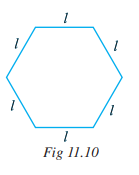
Answer: The side of a hexagon is l.
Therefore, the perimeter of the hexagon $=6 \times side=6l$
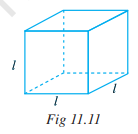
Answer: Length of one edge of cube = l
Number of edges in a cube = 12
So, total length = $12 \times l=12l$
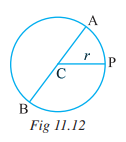
Answer: Length of diameter is double the length of the radius.
Thus,d = 2r
Question: 5 To find sum of three numbers $14,$ $27$ and $13,$ we can have two ways:
(a) We may first add $14$ and $27$ to get $41$ and then add $13$ to it to get the total sum $54$ or
(b) We may add $27$ and $13$ to get $40$ and then add $14$ to get the sum $54.$ Thus, $(14+27)+13=14+(27+13)$
This can be done for any three numbers. This property is known as the associativity of addition of numbers. Express this property which we have already studied in the chapter on Whole Numbers, in a general way, by using variables a, b and c.
Answer: According to the given condition,
$(a+b)+c=a+(b+c)$
NCERT Solutions for Class 6 Maths Chapter 11 E xercise 11.3
Answer: The other expressions are :
(i) $(8\times 5)-7$
$(ii)(8+5)-7$
$(iii)(8+7)-5$
$(iv)(8\times 7)-5$
$(v) 5\times (7+8)$
$(vi) 5\times (7\times 8)$
$(vii) 5-(7+ 8)$
$(viii) 5+(8-7)$
Question: 2 Which out of the following are expressions with numbers only?
(a) $y+3$
(b) $(7\times 20)-8z$
(c) $5(21-7)+7\times 2$
(d) $5$
(e) $3x$
(f) $5-5n$
(g) $(7\times 20)-(5\times 10)-45+p$
Answer: Option (c) and (d) are with numbers only. All other expression contains alphabets
(a) $z+1,z-1,y+17,y-17$
(b) $17y,\frac{y}{17},5z$
(c) $2y+17,2y-17$
(d) $7m,-7m+3,-7m-3$
Answer:
(a) $z+1\rightarrow addition$ $y-17\rightarrow subtraction$
$z-1\rightarrow subtraction$ $y+17\rightarrow addition$
(b) $17y\rightarrow multiplication$ $\frac{y}{17}\rightarrow division$
$5z\rightarrow multiplication$
(c) $2y+17\rightarrow multiplication \, \, and\, \, \, addition$
$2y-17\rightarrow multiplication \, \, and\, \, \, subtraction$
(d) $7m\rightarrow multiplication$
$-7m+3\rightarrow multiplication\, \, and\, \, addition$
$-7m-3\rightarrow multiplication\, \, and\, \, subtraction$
Question: 4(i) Give expressions for the following cases.
(a) $7$ added to $p$
(b) $7$ subtracted from $p$
(c) $p$ multiplied by $7$
(d) $p$ divided by $7$
(e) $7$ subtracted from $-m$
(f) $-p$ multiplied by $5$
(g) $-p$ divided by $5$
(h) $p$ multiplied by $-5$
Answer:
(a) $7$ added to $p$ $=p+7$
(b) $7$ subtracted from $p$ $=p-7$
(c) $p$ multiplied by $7$ $=p\times 7=7p$
(d) $p$ divided by $7$ $=\frac{p}{7}$
(e) $7$ subtracted from $-m$ $=-m-7$
(f) $-p$ multiplied by $5$ $=-5p$
(g) $-p$ divided by $5$ $=\frac{-p}{5}$
(h) $p$ multiplied by $-5$ $=-5p$
Question: 4(ii) Give expressions for the following cases.
(e) $7$ subtracted from $-m$
(f) $-p$ multiplied by $5$
(g) $-p$ divided by $5$
(h) $p$ multiplied by $-5$
Answer:
(e) $7$ subtracted from $-m$ = $-m-7$
(f) $-p$ multiplied by $5$
(g) $-p$ divided by $5$
(h) $p$ multiplied by $-5$
Question:5(i) Give expressions in the following cases.
(a) $11$ added to $2m$
(b) $11$ subtracted from $2m$
c) $5$ times y to which $3$ is added
(d) $5$ times y from which $3$ is subtracted
(e) $y$ is multiplied by $-8$
Answer:
(a) $11$ added to $2m$ $=2m+11$
(b) $11$ subtracted from $2m$ $=2m-11$
c) $5$ times y to which $3$ is added $=5y+3$
(d) $5$ times y from which $3$ is subtracted $=5y-3$
(e) $y$ is multiplied by $-8$ $=-8y$
Question: 5(ii) Give expressions in the following cases.
(f) $y$ is multiplied by $-8$ and then $5$ is added to the result
(g) $y$ is multiplied by $5$ and the result is subtracted from $16$
(h) $y$ is multiplied by $-5$ and the result is added to $16.$
Answer:
(f) $y$ is multiplied by $-8$ and then $5$ is added to the result= $-8y+5$
(g) $y$ is multiplied by $5$ and the result is subtracted from $16$ $=16-5y$
(h) $y$ is multiplied by $-5$ and the result is added to $16.$ $=-5y+16$
Question: 6 (a) Form expressions using $t$ and $4.$ Use not more than one number operation. Every expression must have $t$ in it.
Answer: According to given condition,
$t+4,t-4,4-t,4t,\frac{t}{4},\frac{4}{t}$
Question: 6 (b) Form expressions using $y,$ $2$ and $7$ . Every expression must have $y$ in it. Use only two number operations. These should be different.
Answer: According to the given condition,
$2y+7,2y-7,7y+2,7y-2$
NCERT Solutions for Class 6 Maths Chapter 11 Exercise 11.4
Question:1 Answer the following:
(a) Take Sarita’s present age to be $y$ years
(i) What will be her age $5$ years from now?
(ii) What was her age $3$ years back?
(iii) Sarita’s grandfather is $6$ times her age. What is the age of her grandfather?
(iv) Grandmother is $2$ years younger than grandfather. What is grandmother's age?
(v) Sarita’s father’s age is $5$ years more than $3$ times Sarita’s age. What is her father's age?
Answer: According to the given condition,
(a) (i) $y+5$
(ii) $y-3$
(iii) 6y
(iv) $6y-2$
(v) $3y+5$
Question: 1 (b) The length of a rectangular hall is $4$ meters less than $3$ times the breadth of the hall. What is the length, if the breadth is $b$ meters?
Answer: Breadth = b
And length = (3b-4) meters
Answer: Height of box = h cm
Length of box = 5 times height = 5h cm
Breadth of box = 10 cm less than length = (5h-10) cm
Question: 1 (d) Meena, Beena and Leena are climbing the steps to the hill top. Meena is at step s, Beena is 8 steps ahead and Leena $7$ steps behind. Where are Beena and Meena? The total number of steps to the hilltop is $10$ less than $4$ times what Meena has reached. Express the total number of steps using $s.$
Answer: Meena's position = s
Beena's position = 8 steps ahead = s+8
Leena's position =7 steps behind = s-7
Total steps = $4s-10$
Answer: Speed of bus = v km\h
Distance travelled in 5 hours = 5v km
Remaining distance = 20 km
Totsl distance = $(5v+20)km$
(a) A notebook costs ` $Rs.p$ .A book costs $Rs.3p.$
(b) Tony puts $q$ marbles on the table. He has $8\; q$ marbles in his box.
(c) Our class has $n$ students. The school has $20\; n$ students.
(d) Jaggu is $z$ years old. His uncle is $4\; z$ years old and his aunt is $(4\; z-3)$ years old.
(e) In an arrangement of dots there are $r$ rows. Each row contains $5$ dots.
Answer:
(a) A book cost 3 times the cost of a notebook.
(b) The number of marbles in the box is 8 times marbles on the table.
(c) The total number of students in school is 20 times that in our class.
(d) Jaggu's uncle's age is 4 times the age of Jaggu. Jaggu's aunt is 3 years younger than his uncle.
(e) The total number of dots is 5 times the number of rows.
Question: 3 (a) Given Munnu’s age to be $x$ years, can you guess what $(x-2)$ may show? (Hint : Think of Munnu’s younger brother.)
Can you guess what $(x+4)$ may show? What $(3x+7)$ may show?
Answer:
(a) Munnu's age = x years
Munnu’s younger brother is 2years younger than him = $(x-2)$ years
Munnu’s elder brother is 4years older than him = $(x+4)$ years
His father is 7 years more than thrice of his age = $(3x+7)years$
Question: 3 (b) Given Sara’s age today to be y years. Think of her age in the future or in the past. What will the following expression indicate?
$y+7,$ $y-3,$ $y+4\frac{1}{2},$ $y-2\frac{1}{2}.$
Answer:
Her age in past = $(y-3),(y-2\frac{1}{2})$
Her age in future = $(y+7),(y+4\frac{1}{2})$
Question: 3 (c) Given $n$ students in the class like football, what may $2n$ show? What may $\frac{n}{2}$ show? (Hint : Think of games other than football).
Answer:
Number of students like hockey is twice the students like football, i.e.,2n
Number of students like tennis is half the students like football, i.e., $\frac{n}{2}$
NCERT Solutions for Class 6 Maths Chapter 11 Exercise 11.5
Answer: (a) It is an equation of variable as both sides are equal. The variable is x.
Answer: (b) It is not an equation as LHS is greater than RHS.
Answer: (c) It is an equation with no variable. We may call this a numerical equation
Answer: (d) It is an equation with no variable. It is a numerical equation.
Question: 1(e) State which of the following are equations (with a variable). Give reason for your answer. Identify the variable from the equations with a variable. $5\times 4-8=2\; x$
Answer: (e) It is an equation of variable as both sides are equal. The variable is x.
Answer: (f) It is an equation of variable x.
Answer: (g) It is not an equation because LHS is less than RHS.
Answer: (h) It is an equation of variable as both sides are equal. The variable is n.
Answer: (i) It is an equation with no variable as both sides are equal.
Answer: (j) It is equation of variable p.
Answer: (k) It is an equation of varaible y.
Answer: (l) It is not an equation as LHS is less than RHS.
Answer: (m) It is not an equation as LHS is greater than RHS.
Answer: (n) It is an equation with no variable.
Answer: (o) It is an equation of variable x.
Question: 2 Complete the entries in the third column of the table.
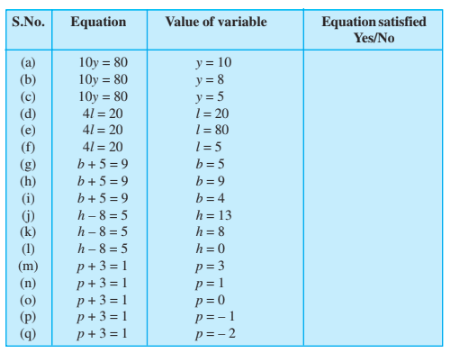
Answer:
S. no. | Equation | Value of variable | Equ.satisfied Yes/No | Sol. of LHS |
(a) | 10 y =80 | y = 10 | No | $10\times 10=100$ |
(b) | 10 y = 80 | y = 8 | Yes | $10\times 8=80$ |
(c) | 10 y = 80 | y = 5 | No | $10\times 5=50$ |
(d) | 4l = 20 | l = 20 | No | $4\times 20=80$ |
(e) | 4l = 20 | l = 80 | No | $4\times 80=320$ |
(f) | 4l = 20 | l =5 | Yes | $4\times 5=20$ |
(g) | b + 5 =9 | b = 5 | No | $5+5=10$ |
(h) | b + 5=9 | b = 9 | Yes | $9+5=14$ |
(i) | b+5=9 | b = 4 | Yes | $13-8=5$ |
(j) | h -8 =5 | h =13 | Yes | $8-8=0$ |
(k) | h -8 =5 | h = 8 | No | $0-8=-8$ |
(l) | h -8 =5 | h = 0 | No | $3+3=6$ |
(m) | p+3=1 | p = 3 | No | $1+3= 4$ |
(n) | p+3=1 | p = 1 | No | $0+3= 3$ |
(o) | p+3=1 | p = 0 | No | $-1+3= 2$ |
(p) | p+3=1 | p = -1 | Yes | $-2+3= 1$ |
(q) | p+3=1 | p = -2 |
(a) $5m=60$ $(10,5,12,15)$
(b) $n+12=20$ $(12,8,20,0)$
(c) $p-5=5$ $(0,10,5,-5)$
(d) $\frac{q}{2}=7$ $(7,2,10,14)$
(e) $r-4=0$ $(4,-4,8,0)$
(f) $x+4=2$ $(-2,0,2,4)$
Answer:
(a) $5m=60$
Putting given values in LHS.
$5\times 10=50$ $5\times 12=60$
$\therefore LHS\neq RHS$ $\therefore LHS= RHS$
m = 10 is not a solution. m = 12 is a solution.
$5\times 5=50$ $5\times 15=75$
$\therefore LHS\neq RHS$ $\therefore LHS\neq RHS$
m = 5 is not a solution. m = 15 is not a solution.
(b) $n+12=20$
Putting given values in LHS.
$12+12=24$ $20+12=32$
$\therefore LHS\neq RHS$ $\therefore LHS\neq RHS$
n = 12 is not a solution. n = 20 is not a solution.
$8+12=20$ $0+12=12$
$\therefore LHS= RHS$ $\therefore LHS\neq RHS$
n = 8 is a solution. n =0 is not a solution.
(c) $p-5=5$
Putting given values in LHS.
$0-5=-5$ $10-5=5$
$\therefore LHS\neq RHS$ $\therefore LHS= RHS$
p =0 is not a solution. p = 10 is a solution.
$5-5=0$ $-5-5=-10$
$\therefore LHS\neq RHS$ $\therefore LHS\neq RHS$
p = 5 is not a solution. p = -5 is not a solution
(d) $\frac{q}{2}=7$
Putting given values in LHS.
$\frac{7}{2}$ $\frac{2}{2}=1$
$\therefore LHS\neq RHS$ $\therefore LHS\neq RHS$
q =7 is not a solution. q = 2 is not a solution.
$\frac{10}{2}=5$ $\frac{14}{2}=7$
$\therefore LHS\neq RHS$ $\therefore LHS= RHS$
q = 10 is not a solution. q = 14 is a solution.
(e) $r-4=0$
Putting given values in LHS.
$4-4=0$ $-4-4=-8$
$\therefore LHS= RHS$ $\therefore LHS\neq RHS$
r =4 is a solution. r = -4 is not a solution.
$8-4=4$ $0-4=-4$
$\therefore LHS\neq RHS$ $\therefore LHS\neq RHS$
r = 8 is not a solution. r = 0 is not a solution
(f) $x+4=2$
Putting given values in LHS.
$-2+4=2$ $0+4=4$
$\therefore LHS= RHS$ $\therefore LHS\neq RHS$
x = -2 is a solution. x = 0 is a solution.
$2+4=6$ $4+4=8$
$\therefore LHS\neq RHS$ $\therefore LHS\neq RHS$
x = 2 is not a solution. x = 4 is not a solution
Question: 4 (a) Complete the table and by inspection of the table find the solution to the equation

Answer: (a)
m | 1 | 2 | 3 | 4 | 5 | 6 | 7 | 8 | 9 | 10 | 11 | 12 | 13 |
m+10 | 11 | 12 | 13 | 14 | 15 | 16 | 17 | 18 | 19 | 20 | 21 | 22 | 23 |
At m = 6, m+10=16
Thus, m =6 is a solution.
Question: 4 (b) Complete the table and by inspection of the table, find the solution to the equation

Answer: (b)
t | 3 | 4 | 5 | 6 | 7 | 8 | 9 | 10 | 11 | 12 | 13 | 14 | 15 | 16 |
5t | 15 | 20 | 25 | 30 | 35 | 40 | 45 | 50 | 55 | 60 | 65 | 70 | 75 | 80 |
At t=7, 5t = 35
Thus, t = 7 is the solution.
Question: 4 (c) Complete the table and find the solution of the equation $z/3=4$ using the table.

Answer: (c)
z | 8 | 9 | 10 | 11 | 12 | 13 | 14 | 15 | 16 | 17 | 18 | 19 | 20 |
$\frac{z}{3}$ | $\frac{8}{3}$ | 3 | $\frac{10}{3}$ | $\frac{11}{3}$ | 4 | $\frac{13}{3}$ | $\frac{14}{3}$ | 5 | $\frac{16}{3}$ | $\frac{17}{3}$ | 6 | $\frac{19}{3}$ | $\frac{20}{3}$ |
At z = 12 , $\frac{z}{3}=4$
Thus, z= 12 is a solution.
Question: 4 (d) Complete the table and find the solution to the equation

Answer: (d)
m | 5 | 6 | 7 | 8 | 9 | 10 | 11 | 12 | 13 | 14 | 15 |
m - 7 | -2 | -1 | 0 | 1 | 2 | 3 | 4 | 5 | 6 | 7 | 8 |
At m=10, m-7 = 3
Thus, m=10 is the solution
Question:5 Solve the following riddles, you may yourself construct such riddles.
(i) Go round a square Counting every corner Thrice and no more! Add the count to me To get exactly thirty four!
(ii) For each day of the week Make an upcount from me If you make no mistake You will get twenty three!
(iii) I am a special number Take away from me a six! A whole cricket team You will still be able to fix!
(iv) Tell me who I am I shall give a pretty clue! You will get me back If you take me out of twenty two!
Answer:
(i) Square has 4 sides.
Counting every corner Thrice and no more!
Implies we go around square thrice,i.e. 12 times.
Add the count to me To get exactly thirty - four!
Let us assume the number as y, we get 34.
12+y=34
$y=34-12=22$
So, 22 is the number .
(ii) If 23 is number for Sunday.
Then counting up, Saturday is 22, Friday is 21, Thursday is 20.
Wednesday is 19, Tuesday is 18, Monday is 17 and Sunday is 16.
Therefore, the number considered is 16.
(iii) Let the number be x.
If we take away 6 from x, we get a cricket team.
x - 6 = 11
$x=11+6=17$
Special number is 17.
(iv) Let the number be x.
22 - x = x
22 = 2x
$x=\frac{22}{2}=11$
The number is 11.
Key Features of NCERT Solutions for Class 6 Maths Chapter 11 Algebra
Additional Tips and Tricks: The class 6 maths algebra often provide additional tips and tricks to simplify calculations and improve efficiency. These insights can help students save time and enhance their problem-solving abilities.
Comprehensive Coverage: The class 6 chapter 11 maths solutions cover all the major topics in the chapter, including variables, constants, algebraic expressions, like terms, coefficients, equations, and solving equations using the trial and error method. Students can be confident that they are learning all the essential concepts required for a strong foundation in algebra.
Conceptual Clarity: The chapter 11 maths class 6 explain the fundamental concepts of algebra in a clear and concise manner. They break down complex topics into simpler steps, making it easier for students to understand.
Step-by-Step Approach: Each exercise in the chapter is solved step-by-step, ensuring that students can follow along and grasp the solution methodology. The solutions include detailed explanations for each step, making it easier for students to learn and apply the concepts.
Also Check
NCERT Books and NCERT Syllabus
NCERT Solutions for Class 6 Mathematics Chapter Wise
| Chapters No. | Chapters Name |
| Chapter - 1 | Knowing Our Numbers |
| Chapter - 2 | Whole Numbers |
| Chapter - 3 | Playing with Numbers |
| Chapter - 4 | Basic Geometrical Ideas |
| Chapter - 5 | Understanding Elementary Shapes |
| Chapter - 6 | Integers |
| Chapter - 7 | Fractions |
| Chapter - 8 | Decimals |
| Chapter - 9 | Data Handling |
| Chapter -10 | Mensuration |
| Chapter -11 | Algebra |
| Chapter -12 | Ratio and Proportion |
| Chapter -13 | Symmetry |
| Chapter -14 | Practical Geometry |
NCERT Solutions for Class 6 - Subject Wise
Benefits of NCERT Solutions for Class 6 Maths Chapter 11 Algebra
- You will learn NCERT Class 6 Maths solutions chapter 11 very easily.
- You can develop an algebraic expression of some real-life problems and solve them which you have learnt in this chapter.
- It is going to help you with your homework as you can get detailed explanations of practice questions given at the end of every topic in the CBSE NCERT solutions for class 6 maths chapter 11 algebra.
- You will get some short tricks and tips to solve some specific problems.
- Tip- Mathematics required more practice to get conceptual clarity. So, you should solve all the NCERT questions including examples and practice questions on your own.
Happy learning!!!
Courses After 12th
Applications for Admissions are open.
As per latest syllabus. Physics formulas, equations, & laws of class 11 & 12th chapters
JEE Main Important Chemistry formulas
Get nowAs per latest syllabus. Chemistry formulas, equations, & laws of class 11 & 12th chapters
JEE Main high scoring chapters and topics
Get nowAs per latest 2024 syllabus. Study 40% syllabus and score upto 100% marks in JEE
JEE Main Important Mathematics Formulas
Get nowAs per latest syllabus. Maths formulas, equations, & theorems of class 11 & 12th chapters
